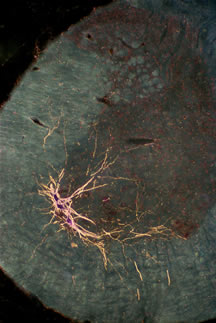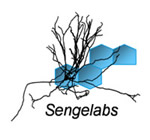Research
Neuroprotective effects of gonadal steroids in models of spinal motoneuron injury

We have demonstrated that the gonadal steroids, testosterone and it’s active metabolites estradiol and dihydritestosterone, have therapeutic effects in the spinal cord, protecting surviving motoneurons from atrophy after injury, and regulating the expression of receptors for trophic factors, proteins critical for the maintenance of normal structure and function. This work has important implications in that if the appropriate trophic support can be provided to injured motoneurons, then the progression of neurodegenerative diseases or lesions could be slowed, and the time required for the recovery of motor function after injury could be reduced.
These findings are important because they demonstrate that gonadal hormones, powerful hormones long associated with sex, could also be playing an important role in the maintenance and repair of the nervous system after injury or disease. These results are directly relevant to clinical application as potential treatment strategies, as well as to basic neuroscience questions on the maintenance of important cellular features.
Our work concentrates on a particular aspect of motoneuron cellular structure, the dendrites. Dendrites are long, heavily branched processes that extend from the neuron cell body, and are essential for the reception and integration of information. Dendrites in motoneurons atrophy after the loss of neighboring motoneurons or peripheral nerve damage, but despite their important functional role, prevention from, or restoration after, atrophy has been largely ignored. This work is novel because while gonadal hormones are known to be important in the development and adult maintenance of highly hormone-sensitive spinal motoneurons involved with reproductive behavior, in our studies we examined hormonal effects in the more typical motoneurons innervating muscles of the leg. Our work demonstrates for the first time that dendritic morphology, and expression of proteins critical for its maintenance, in these general limb motoneurons respond to gonadal hormones, suggesting that the potential therapeutic effects of gonadal steroids on motoneurons apply to all spinal motoneurons.
We have developed several models in the adult rat spinal cord, utilizing induced motoneuron death or spinal cord injury, that allow us to examine potential ways of preventing, or accelerating recovery from, dendritic atrophy in motoneurons that survive initial insult. In our first model, we selectively kill a subpopulation of motoneurons that innervate the quadriceps muscle of the thigh. We then examine the dendritic structure of surviving motoneurons- the death of neighboring motoneurons causes the dendrites of the remaining motoneurons to atrophy. However, treatment with gonadal hormones can prevent or reverse that atrophy.

In our second model, we have examined the effects of spinal cord injury on surviving motoneurons. Spinal cord injury results in lesions that destroy tissue and disrupt spinal tracts,producing deficits in locomotor and autonomic function. In collaboration with colleagues at the Indiana School of Medicine, we have focused on a novel target for treatment after spinal cord injury, surviving spinal motoneurons and their target musculature, with the hope of developing effective treatments to preserve or restore lost function following spinal cord injury. We previously demonstrated that motoneurons, and the muscles they innervate, show pronounced atrophy after spinal cord injury. Importantly, injury-induced atrophy of motoneuron dendrites can be attenuated by treatment with gonadal hormones. Similarly, injury-induced reductions in muscle fiber cross-sectional areas can be prevented by treatment with androgens. Together, these findings suggest that regressive changes in motoneuron and muscle morphology seen after spinal cord injury can be ameliorated by treatment with gonadal hormones, further supporting a role for steroid hormones as neurotherapeutic agents in the injured nervous system.
Motoneuron loss is a significant medical problem, and can result from disease processes or from traumatic injuries. For example, amyotrophic lateral sclerosis (ALS) is a fatal disease characterized by the rapidly progressive loss of motoneurons, affecting 4-8 people per 100,000 population per year, with approximately 5000 new diagnoses made every year in the United States alone. Traumatic spinal cord injuries are even more prevalent: in the United States, more than 10,000 people per year survive a spinal cord injury. After injury or disease, surviving motoneurons respond with marked atrophy, and this atrophy is responsible for some of the movement deficits that accompany degenerative movement disorders and spinal cord trauma. Given that we currently lack the technology to replace dead motoneurons, developing the ability to protect or repair surviving motoneurons is an important goal. Gonadal steroids exhibit a wide array of neuroprotective and neurotherapeutic effects, and the therapeutic effects we observed could potentially have a major impact on the restoration of motor function after injury or disease.
